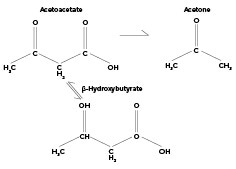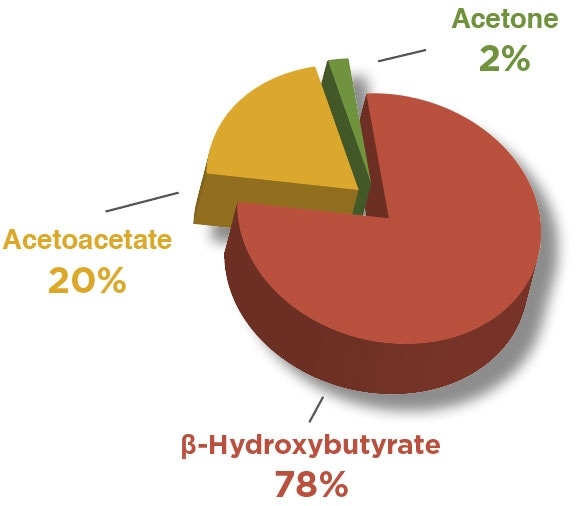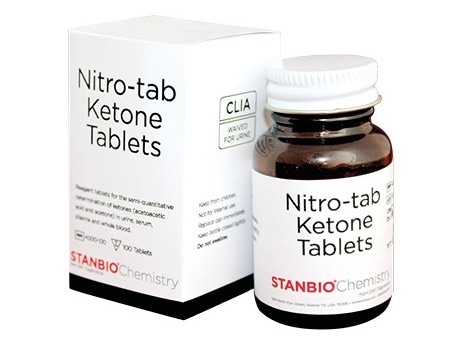
Image Credit: EKF Diagnostics
The body will begin to utilize its stored fat for energy when it doesn’t have a sufficient amount of glucose available to meet its demand for energy.
Chemical byproducts called ketones are produced when these fats are metabolized in the liver. Ordinarily, the liver and other organs will break down ketones into carbon dioxide and water.
If the buildup of ketones goes unnoticed, it can prove fatal. This is a condition known as acidosis. These ketone bodies consist of acetone, acetoacetate, and B-Hydroxybutyrate.

Image Credit: EKF Diagnostics
Why Monitor Ketosis?
In many clinical conditions the detection of ketosis is important, the most important of these being the potentially fatal ketoacidosis in diabetics.
Patients with Type 1 diabetes are prone to developing ketoacidosis. It results from accelerated ketone synthesis, which causes an excessive buildup of ketones in the blood. The body has limited capacity to break them down.1. Diabetic Ketoacidosis (DKA) can be diagnosed through the measurement of the level of ketones. Such measurements are also useful for monitoring the results of treatment.
A clinical suspicion of ketoacidosis can be confirmed by measuring ketone bodies, specifically BHB, along with other lab tests (such as glucose, pH, anion gap, bicarbonate). The patient can also be monitored during treatment for ketoacidosis as B-hydroxybutyrate is quantitative.
As stated by The American Diabetes Association Clinical Practice Recommendations, diabetics should be tested for the presence of ketones under the following circumstances:
- If symptoms of ketoacidosis are present
- During acute illness or stress
- When blood glucose levels consistently exceed 240 mg/dL
- During pregnancy
Other Conditions Where Ketone Testing is Considered to be of Clinical Value
- Pregnant women with gestational diabetes are also at risk of developing elevated ketone levels, which can have a huge effect on the developing fetus2
- Ketoacidosis due to alcoholism3
- Ketosis due to starvation or malnutrition3
- Monitoring special diets used to manage seizures in epilepsy4
Testing for Ketosis

Image Credit: EKF Diagnostics
B-hydroxybutyrate, acetoacetate and acetone are produced when the body begins to break down its stored fats in response to a low supply of energy (glucose).
Urine or blood samples can be tested to monitor ketones (like glucose). Many hospitals still use nitroprusside tablets in the diagnosis of ketoacidosis.

Image Credit: EKF Diagnostics
Ketosis Testing Methods
The nitroprusside urine/serum method or B-Hydroxybutyrate are two commonly used methods for testing ketoacidosis.
Serum B-HB Levels Method
A reliable and quantitative method in the diagnosis and monitoring treatment of ketoacidosis is provided by serum B-HB levels.5
Blood testing of B-Hydroxybutyrate has also been reported to improve clinical outcomes and enhance cost efficiency.6
These improvements are seen in the following areas:
- Earlier detection of clinically significant ketosis
- Improved turn-around times
- Faster resolution of ketoacidosis with a significant reduction of time spent in Critical Decision Unit
- Significant reduction in laboratory testing
B-Hydroxybutyrate Reagent
The B-Hydroxybutyrate (B-HB) reagent is used to detect ketones to identify patients suffering from diabetic ketoacidosis, amongst many other clinical applications.

Image Credit: EKF Diagnostics
Nitroprusside Urine Method
A qualitative assessment of ketosis and ketoacidosis is efficiently provided through the nitroprusside urine method by detecting both acetoacetate and acetone. It does not, however, detect B-Hydroxybutyrate.
- The most reliable indicator of clinically relevant ketosis and ketoacidosis is B-Hydroxybutyrate as it demonstrates excellent stability.
- B-Hydroxybutyrate levels increase more than levels of acetone and acetoacetate during ketosis. This clearly indicates the patient’s trend in metabolic status.
- A better tool for differentiating metabolic acidosis and monitoring therapy is provided through quantitative, objective B-Hydroxybutyrate results.
Furthermore, the nitroprusside method is prone to false positive results from drug interference and false negative results due to reagent deterioration. Urine test results can be significantly affected by fluid intake and urine concentration making this method unreliable.5
Nitro-Tab Ketone Tablets
CLIA waived ketone tablets to measure acetoacetic acid and acetone in urine in 30 seconds, serum in 2 minutes, plasma and whole blood in 10 minutes.

Image Credit: EKF Diagnostics
References
- Foster DW, McGarry JD. The metabolic derangement and treatment of diabetic ketoacidosis. N Engl J Med. 1983;309(3):159-169.
- Rizo T, Metzger BE, Burns WJ, Burns K. Correlations between antepartum maternal metabolism and intelligence of offspring. N Engl J Med. 1991;325(13):911-916.
- Burtis CA, Ashwood ER, eds. Tietz Textbook of Clinical Chemistry. 2nd ed. W.B. Saunders Company, Philadelphia. 1994.
- Chee CM, RN. Spotlight on an Old Remedy, the Ketogenic Diet. Clinical Nursing Practice in Epilepsy,V1, Issue 2, July 1997, pp 13-15.
- Goldstein DE, Little RR, Lorenz RA, Malone JI, Nathan DM, Peterson CM. Tests of glycemia in diabetes Technical review, Diabetes Care. 1995;18(6):896-909.
- Foreback CC, Ph.D, Director Clinical Chemistry/Pathology, Henry Ford Hospital, Detroit, MI. White Paper, 1998.
About EKF Diagnostics
EKF Diagnostics is a global medical diagnostics business with a long history in point-of-care testing and central laboratory manufacturing. Our products have a hard earned reputation for ease of use, reliability and accuracy.
Our core focus is the Point of Care market with over 80,000 haemoglobin, A1c, glucose and lactate analyzers in regular use in more than 100 countries running more than 50m tests every year.
Our range of HbA1c analyzers and glucose analyzers are used in GP surgeries, sports clinics, and diabetes clinics. They deliver fast and reliable results that provide both practitioner and patient with the information they need to make clinical or lifestyle decisions in minutes.
EKF Diagnostics offer the largest range of hemoglobin and hematocrit analyzers on the market, giving physicians and specialists a choice of product with different methodology, measurement speed, connectivity and price options. Our aim is to make blood donation and anaemia screening easier, more affordable and more accessible than ever before.
The EKF Maternal & Women’s Health Point of Care range aims to improve healthcare outcomes for women and children by providing physicians with a suite of products covering pregnancy testing, anaemia screening, fetal scalp lactate testing and post birth creamatocrit measurement.
EKF Diagnostics is also a global manufacturer of central laboratory products including Stanbio Chemistry reagents, benchtop laboratory analyzers, rapid tests and centrifuges. Our chemistry reagents can be used on the majority of analyzers found in hospital laboratories around the world.
The ordinary shares of EKF Diagnostics Holdings plc are traded on the AIM market of the London Stock Exchange.
Sponsored Content Policy: News-Medical.net publishes articles and related content that may be derived from sources where we have existing commercial relationships, provided such content adds value to the core editorial ethos of News-Medical.Net which is to educate and inform site visitors interested in medical research, science, medical devices and treatments.